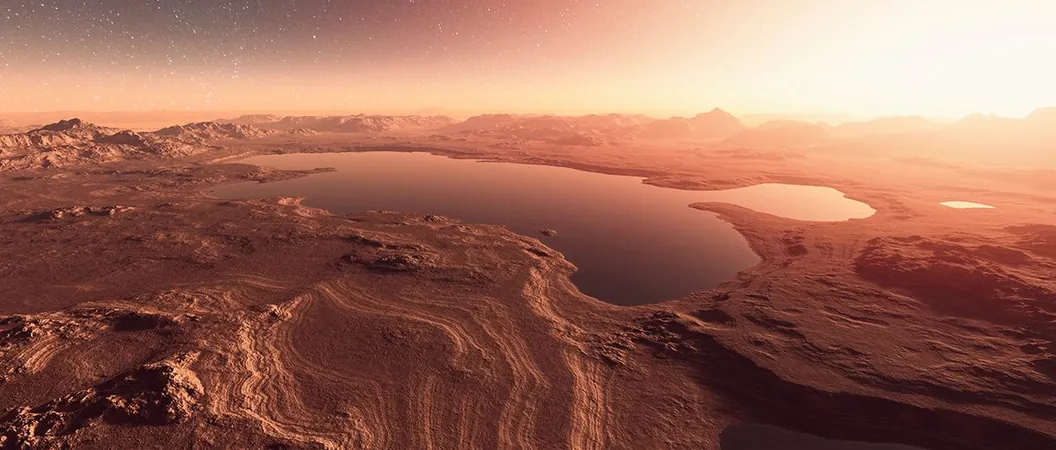
The Unveiling Truth About Water on Mars: Where Did It All Go?
2024-12-28
Author: Yu
Is there really water on Mars? This question has sparked fascination and debate for decades, as scientists continue to uncover new evidence suggesting the presence of water on the Red Planet. However, the images beamed back from rovers and orbiters depict a landscape that is predominantly arid and barren. With announcements of "new discoveries" making headlines several times each year, many wonder if Mars holds more moisture than a rainy day.
A Blast from the Past: The Misconceptions of Early Astronomers
Long before we had the technology to explore Mars, early astronomers had some peculiar ideas about its surface. They believed, in an age devoid of robust scientific evidence, that water flowed abundantly across the Martian terrain. Observing seasonal changes through telescopes, they mistook dark patches for vegetation, convinced that some form of irrigation must be at play. Visionaries like Percival Lowell claimed to have detected a comprehensive network of canals—structures supposedly built by intelligent Martian beings to distribute water.
The Reality of Martian Hydrology
Modern space missions have debunked many of those early beliefs. When NASA's Mariner 9 began sending back images in 1971, it became evident that Mars was a frozen, cratered wasteland rather than a paradise of flowing rivers. These dark regions? Just dust, shifted by relentless Martian winds.
However, subsequent missions have revealed that water does exist on Mars—but not in the familiar liquid state we enjoy on Earth. Instead, large quantities of water ice have been located at the polar regions and buried beneath the surface at mid-latitudes. But this isn't the clean ice you'd scoop from an Earthly glass; it's mixed with dust and dirt, requiring heating to extract usable water.
Hidden Depths and Liquid Reservoirs
NASA's InSight lander, equipped with advanced seismology tools, has uncovered promising hints of liquid water far beneath Mars’ crust. Analysis of the seismic activity suggested the presence of significant reservoirs at depths ranging between 11.5 to 20 kilometers (7 to 12 miles). These deep reserves, however, lie far from easy reach for any future Mars colonization efforts.
The Great Water Disappearance
While present Mars is parched, evidence indicates it was once a very different planet, blanketed with water. Orbital images display remnants of ancient riverbeds and the shoreline of a vast ocean that once dominated the northern hemisphere. Imagine a Jurassic Mars—a striking blue world with flowing streams and a vibrant atmosphere.
So what happened to all that water? Over billions of years, much of it was lost to the harsh conditions of space. Mars’ weak magnetic field and low gravity have permitted the solar wind to gradually strip away its atmosphere, allowing water to evaporate and escape into the cosmos. Today, any remaining water lies frozen in the ground or trapped beneath layers of rock.
The Crucial Importance of Martian Water
Why does the existence of water on Mars matter? Beyond its potential for human consumption, water has the capacity to be broken down into hydrogen and oxygen, crucial components for producing fuel and breathable air. Such resources will be vital for sustaining human life and establishing permanent bases on Mars.
Moreover, the presence of water opens the door to the intriguing possibility that it may harbor life—perhaps in primitive forms—within Martian environments. Scientists remain hopeful that studying Martian water could lead to significant breakthroughs in our understanding of life's requirements.
In short, while Mars may currently resemble a dry desert, the ongoing exploration of its water history raises exciting prospects for future missions and human colonization. The riddles of Mars are far from solved, and every new discovery draws us one step closer to unlocking its many secrets.




 Brasil (PT)
Brasil (PT)
 Canada (EN)
Canada (EN)
 Chile (ES)
Chile (ES)
 España (ES)
España (ES)
 France (FR)
France (FR)
 Hong Kong (EN)
Hong Kong (EN)
 Italia (IT)
Italia (IT)
 日本 (JA)
日本 (JA)
 Magyarország (HU)
Magyarország (HU)
 Norge (NO)
Norge (NO)
 Polska (PL)
Polska (PL)
 Schweiz (DE)
Schweiz (DE)
 Singapore (EN)
Singapore (EN)
 Sverige (SV)
Sverige (SV)
 Suomi (FI)
Suomi (FI)
 Türkiye (TR)
Türkiye (TR)